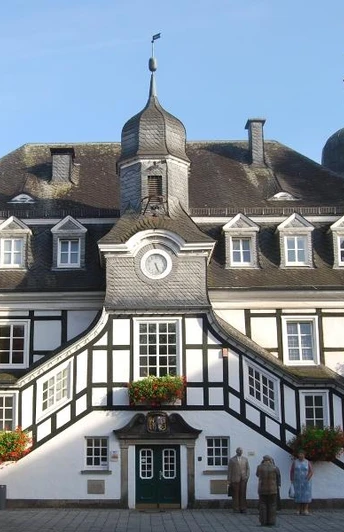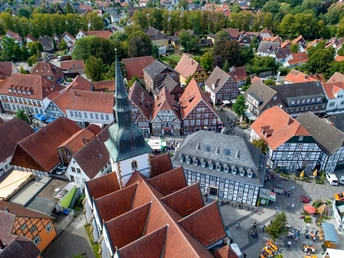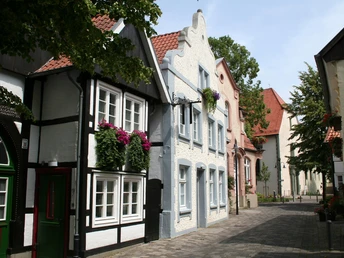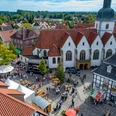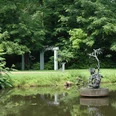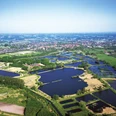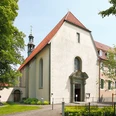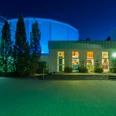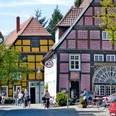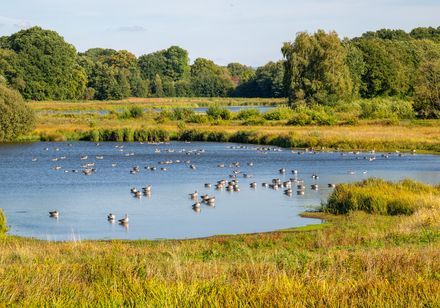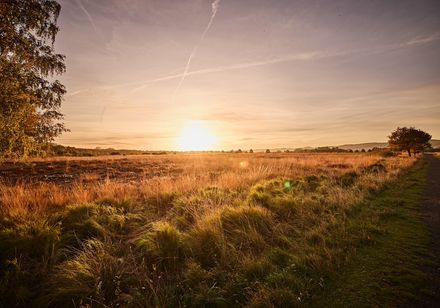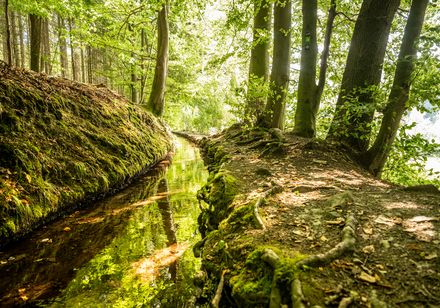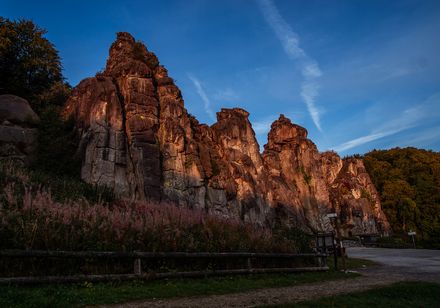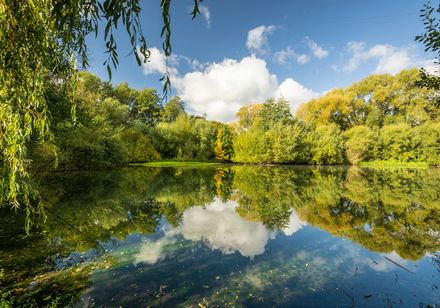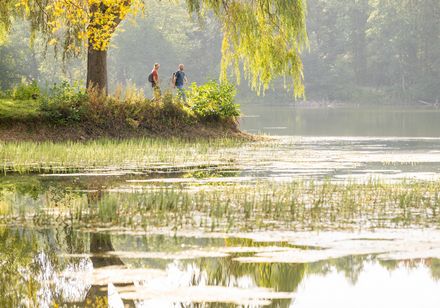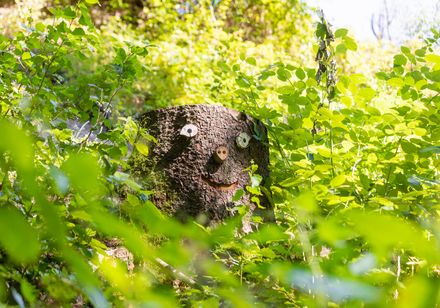- 2:30 h
- 4.90 km
- 5 m
- 5 m
- 77 m
- 79 m
- 2 m
- Start: Historic Rietberg Town Hall
- Destination: Gartenschaupark Rietberg, entrance to the historic town center
The historic town hall is the focal point and landmark of the city. With its picturesque design, it is considered one of the most beautiful in Westphalia. Directly behind it is the Catholic parish church of St. Johannes Baptist and opposite the "Gräfliche Conduvtionshaus".
Further along Klosterstraße, you will find the Heimathaus in a spacious farmhouse with the typical Rietberg "Utlucht". After just a few more meters, you will reach the former Franciscan monastery with its monastery church. The church interior was redesigned during the most recent restoration (2007) according to historical findings. Twelve members of the count's houses of Ostfriesland, Rietberg and Kaunitz were buried in the crypt. The Wilfried Koch monastery garden and sculpture park, once laid out by the Franciscans as a strolling garden, now houses a permanent exhibition of bronze sculptures by the artist Dr. Wilfried Koch. You should not miss a visit to the Kunsthaus - Museum Wilfried Koch and the small garden behind it. Here you will find the life's work of the Varense artist with further sculptures, drawings and books.
A memorial plaque at the north gate commemorates the former fortifications of the castle and town and the old pale north of the Ems and the Markgraben.
The memorial for the fallen was built in 1923 according to the plans of the Wiedenbrück sculptor Heinrich Püts and extended in 1936 with an "ancient round temple" with Ionic columns. At the viewing point (at the confluence of the town moat and both arms of the Ems), you can get an idea of the former fortifications of Rietberg from a display board.
In Müntestraße, which developed into a prestigious residential street for count's officials in the 17th and 18th centuries, you will find, among other things, the manor house, known as Haus Münte. The baroque building, built between 1744 and 1746, housed the count's government. It also served as the residence of the highest administrative official of the Kaunitz-Rietberg princes. The stately half-timbered building opposite, originally a court official's house, has housed the Protestant church since 1903. The representative late Baroque court official's house on the right, dating from 1749, was probably the home of the Rietberg-born court painter and furniture manufacturer Philipp Ferdinand Ludwig Bartscher from 1814. The Deelentor gate on the following house on the left has a unique design for Rietberg. The portal is framed by half-figures. Since 2003, it has housed the studio of Italian-born artist Angelo Monitillo. The narrow half-timbered building opposite is Rietberg's oldest residential building.
The towering brick building on the left-hand side of Pochenstraße was built in 1899 as the Imperial Post Office and the stately manorial building in Rathausstraße housed the local court.
The traditional Müller/Speith organ building workshop in Im Sack street was founded in 1848 and can be visited by appointment. The stately half-timbered house in which the organ building workshop is located is one of the much more elaborately designed residences of the count's chancellery officials in Rietberg.
There are two gardens in the small alleyway that follows. Beautiful roses bloom in the romantic Bürgergärtchen in summer. Diagonally opposite on the other side of the alley is the Drostengarten, in the middle of which a geometrically laid out garden with borders, hedges, paths and visual axes was created in 2008 in the style of traditional stately gardens in Rietberg from the 18th century. In the garden there is a steel sculpture entitled "Full Moon", whose "floating halves of the moon" under yew trees and above the ivy create an ever-changing impression depending on the sunlight.
Seven wayside shrines placed at greater intervals with depictions of the suffering and death of St. John of Nepomuk have given the Johannesweg its name. The bright white St. John's Chapel is Rietberg's most important cultural and historical monument.
Enjoy a view of the Rietberg fish ponds nature reserve from the observation tower in the "Living Cultural History" section of the garden show park.
Waypoints
Good to know
Best to visit
Directions
Tour information
Familiy-Friendly
Loop Road
Stop at an Inn
Equipment
Directions & Parking facilities
A2 Hanover (north and east - Berlin): A2, exit Gütersloh / Rietberg - via country road
A2 west (from Kamener Kreuz) : A2, exit Rheda-Wiedenbrück/Rietberg
A44 - West: Exit Erwitte - from there via the B1, B55 via Lippstadt to the junction B55/L836 towards Bokel. Turn right there via the L836 (Bokeler Straße) to Rietberg-Bokel and then on to Rietberg.
A 33 - south: A 33 to the Paderborn/Schloß Neuhaus exit, from there onto the B64 - continue via Delbrück to Rietberg (B64)
Address for navigation systems: Torfweg 53, 33397 Rietberg (ZOB)
Free parking (for up to 2 hours) is available in the historic city center (parking disc required). Barrier-free parking spaces are also available.
Temporary, free parking spaces are available at the ZOB (Torfweg 53) and at the Super Schnäppchen parking lot (Heinrich-Kuper-Str. 3).
You can reach Rietberg from Gütersloh central bus station with bus line 77
From Lippstadt train station with line 80.1
From Rheda-Wiedenbrück train station with line 76
Stop in Rietberg: Central bus station. From the central bus station, you can reach the historic town hall (starting point) on foot in approx. 5 minutes.
Always know what's running: The smart number for buses and trains in NRW: 01806 504030.
(20 cents/connection from landlines and a maximum of 60 cents/connection from mobile networks)
Further information on timetables is also available at:
Additional information
www.stadt-rietberg.de
Literature
License (master data)
Author´s Tip / Recommendation of the author
Safety guidelines
Please take care when crossing the roads.
Please be considerate of cyclists.
You will find numerous places to stop for refreshments along the route.
